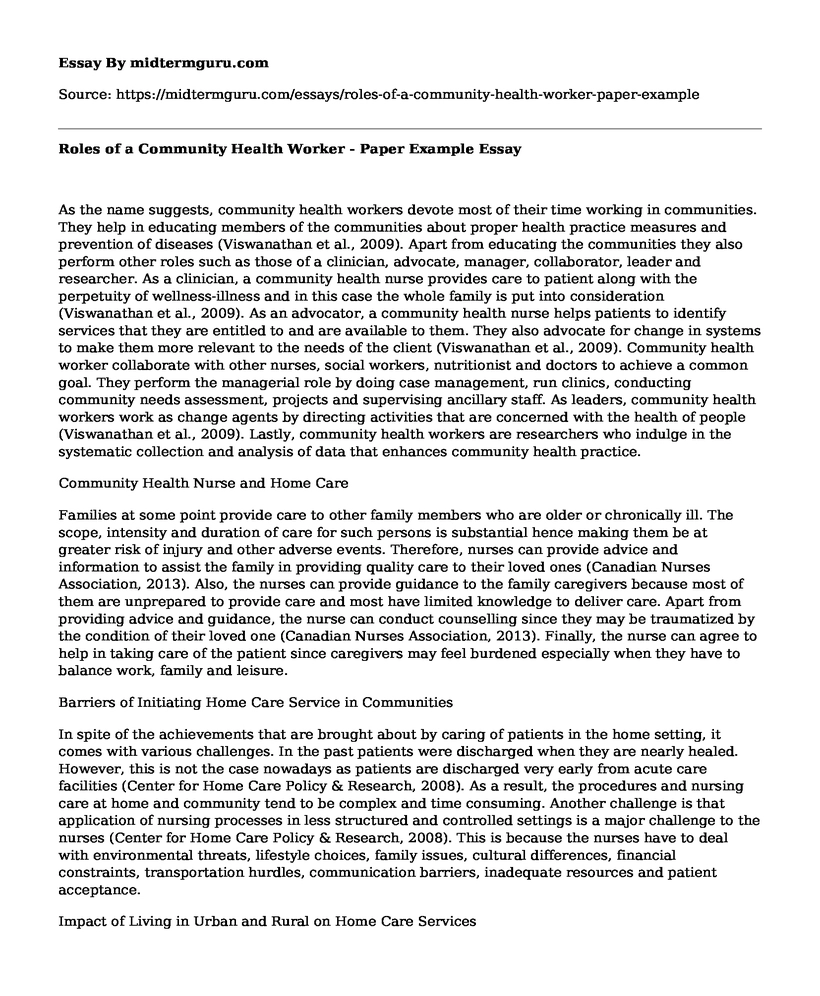As the name suggests, community health workers devote most of their time working in communities. They help in educating members of the communities about proper health practice measures and prevention of diseases (Viswanathan et al., 2009). Apart from educating the communities they also perform other roles such as those of a clinician, advocate, manager, collaborator, leader and researcher. As a clinician, a community health nurse provides care to patient along with the perpetuity of wellness-illness and in this case the whole family is put into consideration (Viswanathan et al., 2009). As an advocator, a community health nurse helps patients to identify services that they are entitled to and are available to them. They also advocate for change in systems to make them more relevant to the needs of the client (Viswanathan et al., 2009). Community health worker collaborate with other nurses, social workers, nutritionist and doctors to achieve a common goal. They perform the managerial role by doing case management, run clinics, conducting community needs assessment, projects and supervising ancillary staff. As leaders, community health workers work as change agents by directing activities that are concerned with the health of people (Viswanathan et al., 2009). Lastly, community health workers are researchers who indulge in the systematic collection and analysis of data that enhances community health practice.
Community Health Nurse and Home Care
Families at some point provide care to other family members who are older or chronically ill. The scope, intensity and duration of care for such persons is substantial hence making them be at greater risk of injury and other adverse events. Therefore, nurses can provide advice and information to assist the family in providing quality care to their loved ones (Canadian Nurses Association, 2013). Also, the nurses can provide guidance to the family caregivers because most of them are unprepared to provide care and most have limited knowledge to deliver care. Apart from providing advice and guidance, the nurse can conduct counselling since they may be traumatized by the condition of their loved one (Canadian Nurses Association, 2013). Finally, the nurse can agree to help in taking care of the patient since caregivers may feel burdened especially when they have to balance work, family and leisure.
Barriers of Initiating Home Care Service in Communities
In spite of the achievements that are brought about by caring of patients in the home setting, it comes with various challenges. In the past patients were discharged when they are nearly healed. However, this is not the case nowadays as patients are discharged very early from acute care facilities (Center for Home Care Policy & Research, 2008). As a result, the procedures and nursing care at home and community tend to be complex and time consuming. Another challenge is that application of nursing processes in less structured and controlled settings is a major challenge to the nurses (Center for Home Care Policy & Research, 2008). This is because the nurses have to deal with environmental threats, lifestyle choices, family issues, cultural differences, financial constraints, transportation hurdles, communication barriers, inadequate resources and patient acceptance.
Impact of Living in Urban and Rural on Home Care Services
Access to home care services varies between people living in rural areas and those in urban areas. Many characteristics of rural areas create obstacles that hinder patients from accessing home health care (Adams, Michel, DeFrates, & Corbett, 2001). For instance, educational attainment and per capita income are lower for rural residents when compared to their urban counterparts. Additionally, rural jobs are usually not as highly skilled as urban ones. Therefore, it is less likely that rural residents will have private insurance thus depend on government health policies. Another characteristic of rural communities that affects home care services is their geographical isolation (Adams et al., 2001). Unlike urban areas, geographical isolation in rural areas implies that it will take a relatively longer time for needed services to reach residents. These rural characteristics makes it difficult for residents to access home health care especially in hard-to-to reach locations.
References
Adams, C. E., Michel, Y., DeFrates, D., & Corbett, C. F. (2001). Effect of locale on health status and direct care time of rural versus urban home health patients. Journal of Nursing Administration, 31(5), 244-251.
Canadian Nurses Association. (2013). Optimizing the role of nursing in home health (1st ed.). Ottawa: Canadian Nurses Association.
Center for Home Care Policy & Research,. (2008). Promoting excellence in geriatric homecare (1st ed.). New York: Center for Home Care Policy & Research.
Viswanathan, M., Kraschnewski, J., Nishikawa, B., Morgan, L. C., Thieda, P., Honeycutt, A., ... & Jonas, D. (2009). Outcomes of community health worker interventions.
Cite this page
Roles of a Community Health Worker - Paper Example. (2021, May 31). Retrieved from https://midtermguru.com/essays/roles-of-a-community-health-worker-paper-example
If you are the original author of this essay and no longer wish to have it published on the midtermguru.com website, please click below to request its removal:
- Distinct Characteristics of Nursing - Paper Example
- Paper Example on Sickle Cell Disease
- Essay Sample on Supplemental Nutrition
- Risk Factors for Birth Defects: Smoking, Alcohol, Drugs, Nutrition - Research Paper
- 25 Years of Improving Community Health Through Collaboration - Essay Sample
- Nurses: Understanding Standard Nursing Terminologies - Essay Sample
- Similarities in The Bear Came Over The Mountain and Away From Her - Essay Sample







